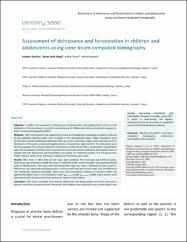| dc.contributor.author | Akbulut, Aslıhan | |
| dc.contributor.author | Ballı Akgöl, Beyza | |
| dc.contributor.author | Orhan, Kaan | |
| dc.contributor.author | Bayram, Merve | |
| dc.date.accessioned | 2021-08-20T05:55:36Z | |
| dc.date.available | 2021-08-20T05:55:36Z | |
| dc.date.issued | 2021 | en_US |
| dc.identifier.citation | Akbulut, A., Ballı Akgöl, B., Orhan, K. ve Bayram, M. (2021). Assessment of dehiscence and fenestration in children and adolescents using cone beam computed tomography. Dentistry 3000, 9(1). https://dx.doi.org/10.5195/D3000.2021.143 | en_US |
| dc.identifier.issn | 2167-8677 | |
| dc.identifier.uri | https://dx.doi.org/10.5195/D3000.2021.143 | |
| dc.identifier.uri | https://hdl.handle.net/20.500.12511/7888 | |
| dc.description.abstract | Objective: To define the prevalence of dehiscence and fenestration and classify them in terms of the localization of fenestrations in a random sampled group of children and adolescent patients using cone-beam computed tomography (CBCT). Methods: CBCT performed at the Department of Oral and Maxillofacial Radiology of patients referred by the paediatric dentistry clinic were included in this retrospective study. Image evaluations were performed by dentomaxillofacial radiologist (AA, asst. prof.), and these images were examined in three dimensions of the axial, coronal, and sagittal planes. Intraexaminer agreement for the evaluations were found acceptable. The presence/absence of dehiscence and/or fenestration, fenestration's classification type, and localization of defects were recorded. Moreover, the presence/absence of periapical lesion in related root with dehiscence and fenestration was noted. For statistical analysis, The Chi-Square test, Fisher Freeman Halton Test, and Yates' Continuity of Correction were used. Results: 3061 roots in 1801 teeth of 120 cases were analyzed. The mean age was 9.97±2.22 years. Dehiscence was detected in 261(8.5%) roots of 161(8.9%) teeth, and fenestration was detected 63(2%) roots of 36(2%) teeth. The most common fenestration type was Type I, followed by Type II and IV. Dehiscence was observed more frequently in primary teeth than permanent teeth, and the difference was statistically significant (p:0.000). Dehiscence and fenestration incidence in maxillary teeth was significantly higher than in the mandibular teeth (pdehiscence:0.000, pfenestration:0.004). Apical lesions were observed more in primary teeth than permanent teeth for both defects. Conclusion: This study concludes that alveolar dehiscence and fenestrations are more common in primary teeth than permanent teeth. Moreover, these defects were detected more for the teeth in the maxilla. Concerning endodontic and orthodontic therapies in maxilla, use of CBCT is useful in determining the region's anatomical structure accurately in suspected cases of child and adolescent patients. | en_US |
| dc.language.iso | eng | en_US |
| dc.publisher | University Library System, University of Pittsburgh | en_US |
| dc.rights | info:eu-repo/semantics/openAccess | en_US |
| dc.subject | Alveolar Bone Defect | en_US |
| dc.subject | Cone-Beam Computed Tomography | en_US |
| dc.subject | Dehiscence | en_US |
| dc.subject | Fenestration | en_US |
| dc.subject | Primary Tooth | en_US |
| dc.title | Assessment of dehiscence and fenestration in children and adolescents using cone beam computed tomography | en_US |
| dc.type | article | en_US |
| dc.relation.ispartof | Dentistry 3000 | en_US |
| dc.department | İstanbul Medipol Üniversitesi, Diş Hekimliği Fakültesi, Ağız, Diş ve Çene Radyolojisi Ana Bilim Dalı | en_US |
| dc.department | İstanbul Medipol Üniversitesi, Diş Hekimliği Fakültesi, Çocuk Diş Hekimliği Ana Bilim Dalı | en_US |
| dc.authorid | 0000-0001-7931-4464 | en_US |
| dc.authorid | 0000-0002-8440-367X | en_US |
| dc.identifier.volume | 9 | en_US |
| dc.identifier.issue | 1 | en_US |
| dc.relation.publicationcategory | Makale - Uluslararası Hakemli Dergi - Kurum Öğretim Elemanı | en_US |
| dc.identifier.doi | 10.5195/D3000.2021.143 | en_US |
| dc.identifier.scopusquality | Q4 | en_US |


















